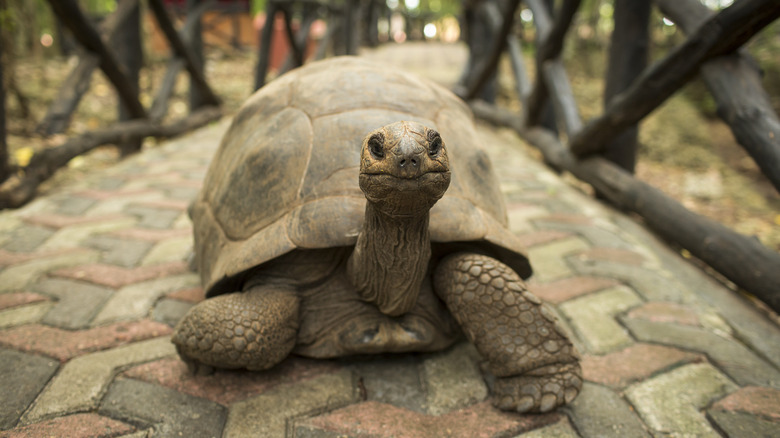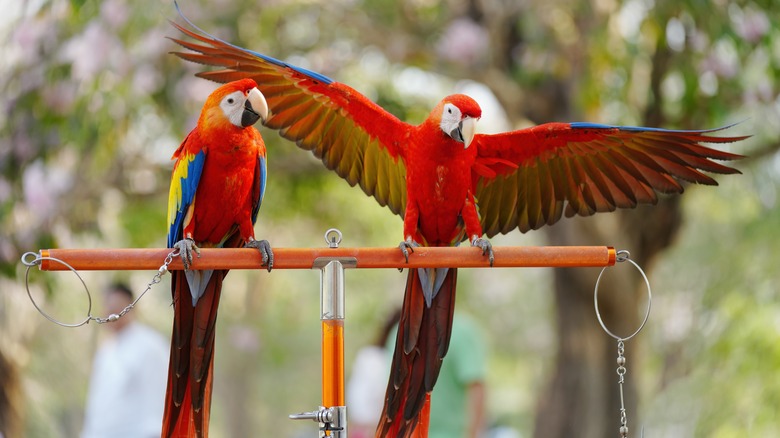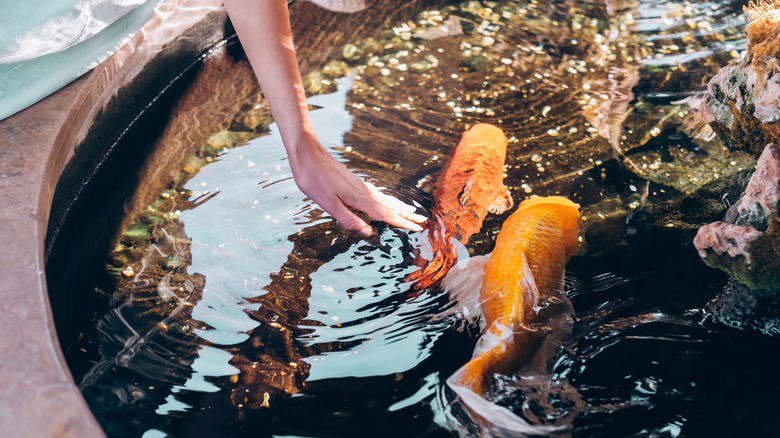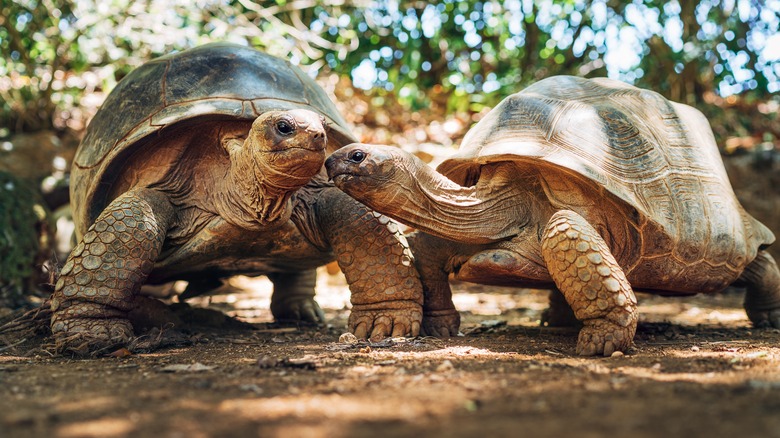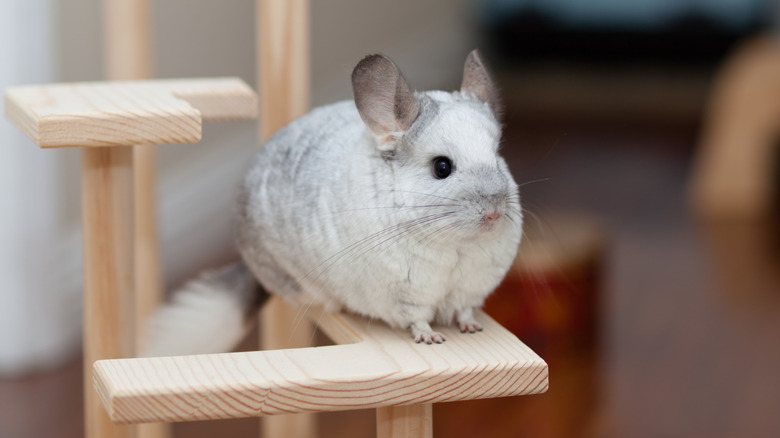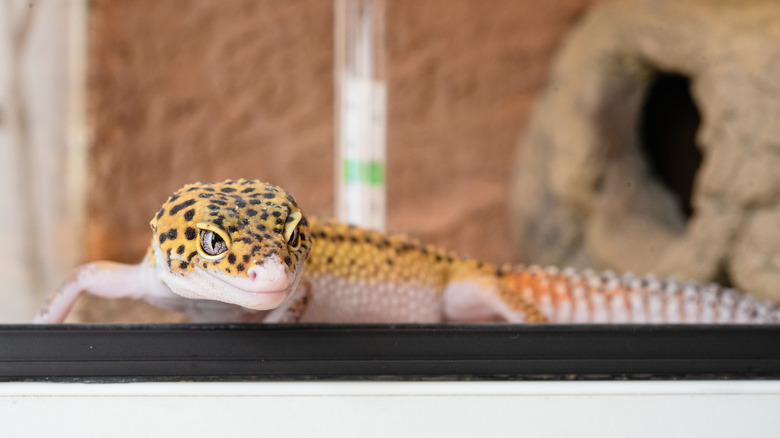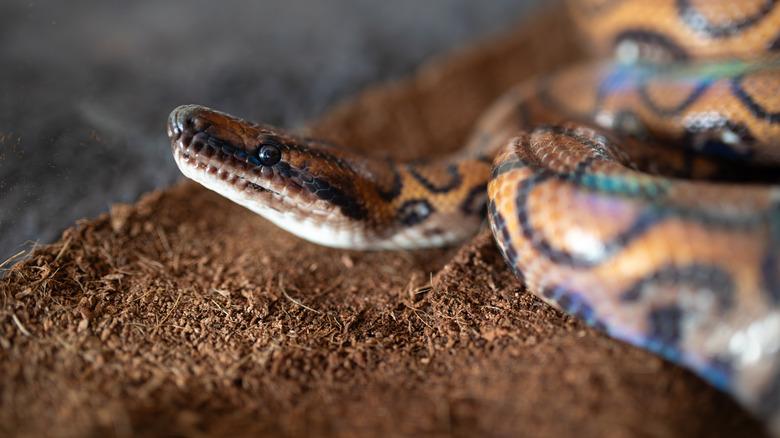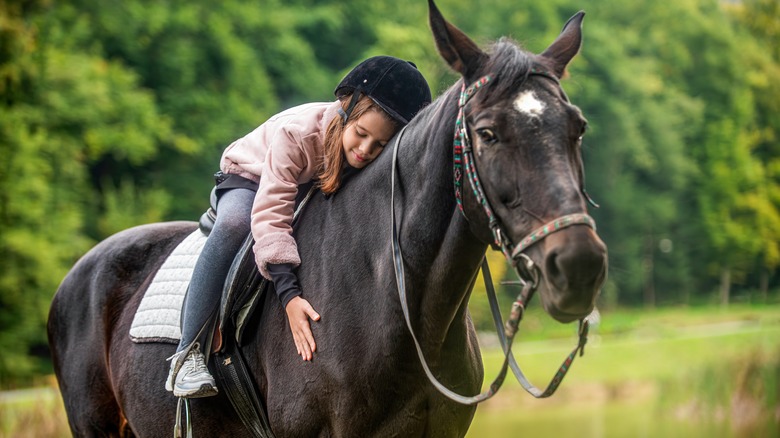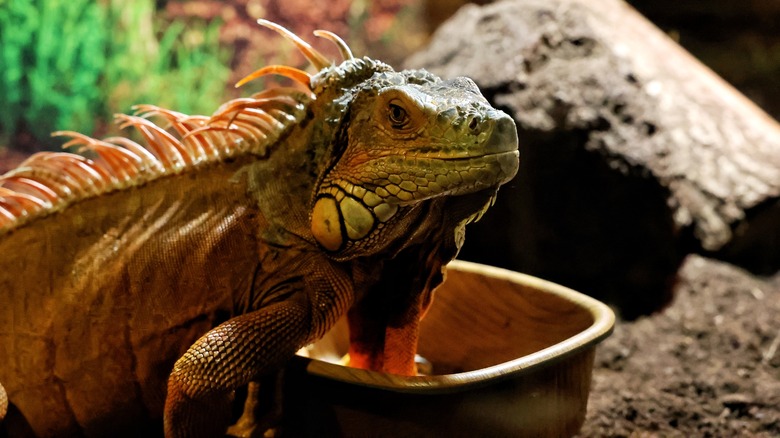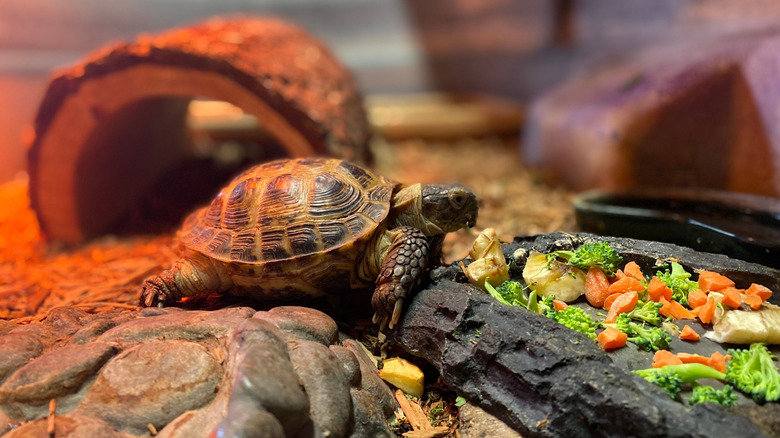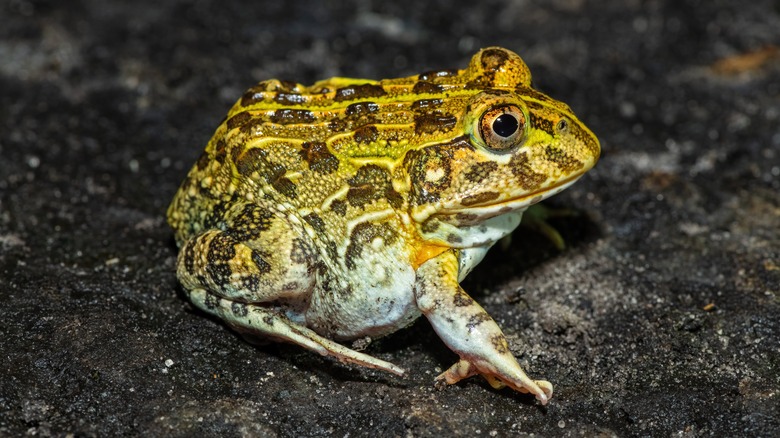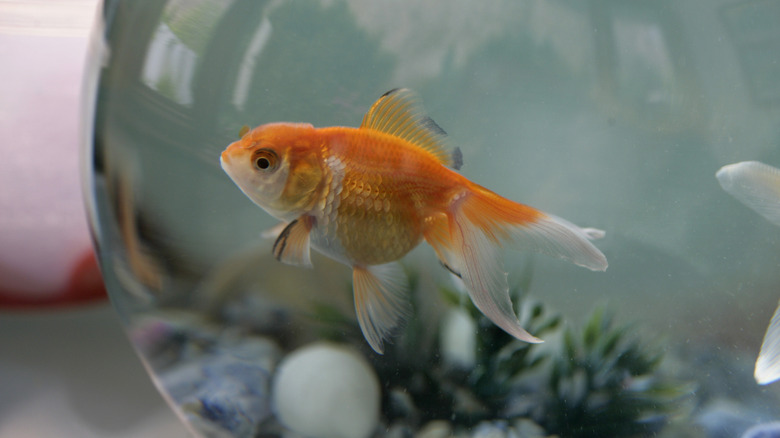12 Pets With The Longest Lifespans (Beyond Cats And Dogs)
Time spent with pets, no matter how long, always seems too brief. Both cats and dogs have much shorter average lifespans than their human counterparts, and owners will likely have to say goodbye one day. This can be a difficult realization, and when searching out potential new family members, many people will look for healthy, long-living canine and feline breeds to ensure they can build many fond memories together.
Yet, there are many possible furry, scaled, and feathered friends outside of the two most popular pets, some of which can live as long as (or longer than) the humans that care for them. If you're prepared to make such a considerable commitment and can ensure that they will continue to be cared for in the event that they outlive you, these animals can keep you company for decades to come.
1. Macaws
Macaws, members of the parrot family, span 17 recognized breeds, with the blue and gold variety appearing the most often as a household pet. Many of these beautiful and highly intelligent birds come from troubled backgrounds, and bringing one into a home can prove challenging for even the most patient owner. Both the illegal trade of exotic avians and abandonment due to a lack of awareness of the care required have become prevailing problems for the industry.
Macaws are not domesticated pets; they still hold on to many of their instincts, require a lot of stimulation and attention, and can grow destructive if their needs go unmet. For this reason, preparing yourself by learning as much as possible about owning a macaw and the work that entails is vital to success. Adopting from a shelter also goes a long way in showing compassion for those birds in desperate need of a home.
In the right conditions, the macaw life cycle averages an impressive 25 to 35 years, with some making it 60 or beyond. Specific sub-species have greater longevity, with the scarlet macaw able to live between 50 and 80 years on average, with certain birds even sneaking into their 100s. Charlie, Winston Churchill's purported blue and gold macaw, supposedly lived to at least age 114, potentially making it the oldest on record.
2. Koi
While they've recently gained popularity in the West, koi fish have long held significance in Asian cultures. Japan, in particular, has integrated the carp into various aspects of its society, from art to festivities. The koi symbolizes perseverance and good fortune in the country, and is said to bring prosperity to those who care for them. The name "koi" is also a homophone for a different word that translates to "affection" or "love," further leading to its deep resonance with the Japanese.
Cultural significance plays a role in the lifespan of a koi as a pet (not to imply that owners in the West afford less care to the precious fish). Different environments, diets, climates, and breeding practices show that koi in Japan have an average lifespan of 40 years, while the domesticated koi in the West have a life expectancy of only around 15 years. One remarkable carp, Hanako, reportedly lived to be 226 years old.
As pets, koi fish make a unique addition to any home, particularly when highlighting a garden space. Koi come in over 100 varieties, all with unique markings — no two carps are alike in color and pattern. Highly social, they thrive with larger groups, and can cohabitate with other fish species. Able to reach up to 3 feet long, with some owners choosing to make their koi grow faster, the care and space needed for the remarkable fish make them quite an undertaking, but certainly worth it for pet parents with a complementary lifestyle.
3. Tortoises
Both turtles and tortoises can boast an impressive life span despite their differences – tortoises live on land and have a distinct shell shape and nutritional needs. Caring for a tortoise involves having ample space for an enclosure that mimics its natural habitat. Maintaining the right temperature and adhering to a proper diet are just some of the many considerations a potential caretaker needs to factor in before bringing a tortoise into their home. Adhering to local laws is also essential, as some states restrict tortoise ownership.
Tortoises can be highly social creatures, with some breeds recognizing their owner by sight and sound and seeking attention and companionship. Likewise, the age range of a pet tortoise can vary drastically; desert species can reach up to 100 years old, while forest species range from 60 to 90, though hitting the 100-year mark is not uncommon. Tortoises are often considered "heirloom pets" because their longevity requires more than one generation to care for them.
The aldabra tortoise is one of the longest-lived and largest species, with males weighing as much as 550 pounds and both sexes hitting ages beyond 150 years old. The oldest living tortoise, an aldabra named Jonathan, turned 191 in December 2023.
4. Chinchillas
Originating in the Andes Mountains of South America, chinchillas made their debut as pets in North America relatively recently. They first appeared in the U.S. during the 1920s, before experiencing a market boom in the '60s. Adorable to look at and soft to the touch, the rodents have charmed many people. Yet, they can present various challenges for an unprepared owner.
Post-pandemic, many shelters saw an influx of chinchillas as their popularity rose but their involved care requirements took would-be pet parents by surprise. While touted as hypoallergenic, chinchillas need frequent dust baths and consume hay, both of which can trigger allergies in certain owners. Additionally, chinchillas are highly social creatures used to living in colonies of hundreds; sellers recommend adopting them in pairs as result. While they may show their human companions affection, some don't like being picked up or petted. The athletic rodent can also jump up to 6 feet, and they need room to exercise.
Chinchillas come with a considerable life span ranging between 10 to 20 years, making them a greater commitment than most pet rodents (the classroom favorite hamster only lives 1 to 5 years). However, those looking for a long-term companion will find much to love about the chinchilla, a unique pet bursting with personality.
5. Geckos
Geckos have become a favorite for those new to caring for reptiles. They are small, relatively low maintenance, and don't need the same amount of space as other lizards. While there are over 1,600 different species of gecko, only a small portion are kept as pets. The leopard gecko is the most popular, followed closely by the crested gecko.
Hailing from several countries throughout the Middle East, the nocturnal leopard gecko lives off a diet of insects. Its docile nature during the day and cheaper food requirements make it a good pet for beginners, provided its owner can supply the space, temperature, and meals needed to keep them healthy. With a gradual introduction to being handled, the leopard gecko can also become accustomed to its caretaker, allowing them to observe and interact with it.
When properly looked after, the leopard gecko has an average lifespan of 15 years but can live up to 20 — a lot of value for a lizard that only reaches 7 to 11 inches long. The leopard gecko makes a great long-lived companion for anyone with a reptile fascination who wants an easy-to-care-for pet.
6. Boas
While a potential pet parent will need to check local laws to ensure the legality of ownership in their area and prepare by buying an ample-sized enclosure, boas are relatively low-maintenance pets. Moderately docile, they may act out when young, but tend to become easier to handle as they age. Feeding requirements are also affordable, as they need only one rodent every 10 days. The combination of being able to observe and interact with boas has made them cornerstone pets for reptile enthusiasts.
Boas come in three different genuses –constrictor, imperator, and sigma — which further break down into subspecies and regions. Patterning and colors also play a role in some collectors' choices, as rarity can make a snake more valued. While many species are kept as pets, the Colombian rainbow boa is the most popular thanks to its modest size of 5 to 6 feet and purchase accessibility for new owners.
The Colombian rainbow boa also benefits from a long life span; when properly cared, the reptile lives an average of 20 years. Ben, a member of the species born in 1974, lived until 2016, making him just over 42 years old at the time of his death.
7. Horses
While dogs have played a key role in human progression as the oldest domesticated animal (they date as far back as 11,000 years to the conclusion of the last Ice Age), horses were arguably the most integral animals in terms of shaping culture and industry, both old and new. "Horse domestication was an absolute lightning strike in human history, leading to incredible, widespread, and lasting social transformations all across the ancient world," assistant professor and archaeology curator William Taylor shared with CNN. Whether providing literal horsepower to help transport people or featuring in warfare, the horse has become a fundamental and deeply admired creatures to many.
Appreciation for equines extends past their historical significance. Many individuals are drawn to horse culture, and owning one comes with access to and passionate community. Horses are compassionate and intelligent, each with a unique personality that makes them unforgettable companion animals. Price and upkeep are the most significant considerations before taking the plunge, as horses are one of the most expensive types of pets you can buy, due in part to their longevity.
Many horse breeds live an average of 25 to 30 years, but there is a lot of variance based on type and use. The most popular breed in the United States, the American quarter horse, often lives from 20 to 30 years or more, while a Shetland pony can hit 30 to 40 years of age. Typically, the smaller the breed, the longer the life span. The Guinness Book of World Records lists Old Billy, who died at age 62, as the oldest horse to have lived.
8. Pigs
The popularity of pot-bellied pigs as pets has waxed and waned, with owners sharing their cute little piggies on the internet. Porcines are extremely intelligent animals, capable of working out problems and performing complex tasks; they also have an impressive long-term memory. As pets, pigs' need a lot of stimulation and can act out if not given the proper care. Size also factors in, as most so-called 'micro-pigs' can reach between 75 to 150 pounds (some even hit the 200-pound mark). For an inexperienced caretaker, this can be a lot to handle, with around 90% of pigs rehomed within the first year of ownership in the U.S., according to Anna Key, vice president of the North American Potbellied Pig Association (via CBS News).
Pot-bellied pigs can live for 15 to 18 years. However, their longevity depends on many factors; their lifespans can be shortened by inbreeding and improper care, including abandonment stress. Many pot-bellied pigs only live until they are 5 years old due to the various issues that can occur. According to the Guinness Book of World Records, the oldest pig in captivity was Baby Jane from Mundelein, Illinois, who died at age 23.
9. Iguanas
Keeping an iguana as a pet is quite a remarkable experience, as even just watching them grow up is fascinating. Babies start at a length of 10 to 16 inches, but they can reach up to 7 feet, including their tails. With such a big lizard, space, proper care, diet, and environment are essential to ensure their health and longevity. While iguanas can be affectionate and handled by their owners, this takes a lot of patience, as they are naturally wary of human interaction. The large, scaly pet also requires awareness, as an aggressive or antagonized iguana packs a punch in its tail, with a whipping motion strong enough to break human bones.
The most popular type of iguana kept as a pet is the common green, but the desert, rhinoceros, spiny-tailed, and blue are also options for reptile enthusiasts. A well-cared-for iguana can easily make it to the age of 20, making them great long-term companions; it also helps that they are diurnal, meaning they rise with the sun and will always be active while you are awake. The oldest living iguana on record was a common green, Zipper, who lived for 29 years and 11 months before passing.
10. Turtles
While tortoises are primarily land animals, with less requirement for water, turtles need tanks that allow them plenty of room to soak or swim. The shelled pet can thrive as long as an owner can provide the proper environment, including a filtration system to keep their turtle tank clear and the right food. As omnivores, turtles need a well-balanced diet of meat and veg.
Pet turtles may be affectionate with their owners; they can recognize them by sight and sound and will often flock to their favorite people. While you can hold the little-shelled cuties, approach handling them with caution. Not only can a scared turtle bite its owner, but they may carry salmonella; cleaning your hands after handling is essential when interacting with any breed.
The most common pet turtle is the red-eared slider, which can reach 12 to 14 inches long and live up to 30 years. However, if you prioritize longevity, the wood turtle is the ideal choice. It is considered a threatened species and restricted in various states, making it essential to check local laws before adopting one. It is not uncommon for a wood turtle to live into its 80s, which means owners should prepare to have another family member inherit the pet.
11. Frogs
Frogs can make for an ideal pet for those looking for an easy-to-maintain, observable companion. Due to their sensitive skin, you won't be able to handle your frog often, but they can still form bonds with an owner once they realize they are their source of food. Besides the cost of setting up a tank, amphibians can be affordable choices for a prospective caretaker; just be aware of various health concerns related to their environment and purchase from a reputable breeder.
There are over 7,400 species of frogs, with around 2,000 considered threatened. Of the many varieties, only a few are kept as pets. The most popular choice is the white tree frog due to its size, friendly temperament, and ease of care. It has an average lifespan of 16 years.
Another pet amphibian known for its longevity is the African bullfrog, which has a lifespan of around 20 years in the wild. With proper care, it can live upwards of 40 years in captivity. With this lifespan comes extra responsibility, as this is a large breed of frog, with males growing as big as 0.8 feet long and weighing as much as 5 pounds.
12. Goldfish
Seeing goldfish on this list may surprise some, as they're often considered a starter pet for kids and viewed as "disposable." The myth of their supposed three-second memory and the media portrayal of the little fish has not helped this perspective. However, studies on goldfish have determined them to be more intelligent than initially thought, including possessing a longer-term memory. These studies have shown that the fish can navigate puzzles and remember them when rechallenged a month later. Some research even points to them recognizing each other after a long separation.
Proper care and keeping a goldfish happy can help ensure its longevity and that an owner can appreciate their pet for years. Goldfish do better in open, outdoor ponds (they can cohabitate with koi), where they have more oxygen. As a companion, a goldfish may not be a pet you can hold, but its beautiful coloring and lively personality make it fascinating to observe.
While not quite carrying the impressive longevity of their koi counterparts, a goldfish can boast a lifespan of 10 to 15 years. Keeping them in a proper tank is vital, as a bowl without the appropriate filtration system will dramatically shorten their lifespan. The oldest living goldfish, whose scales turned silver with age, was Tish, who lived to see age 43.
